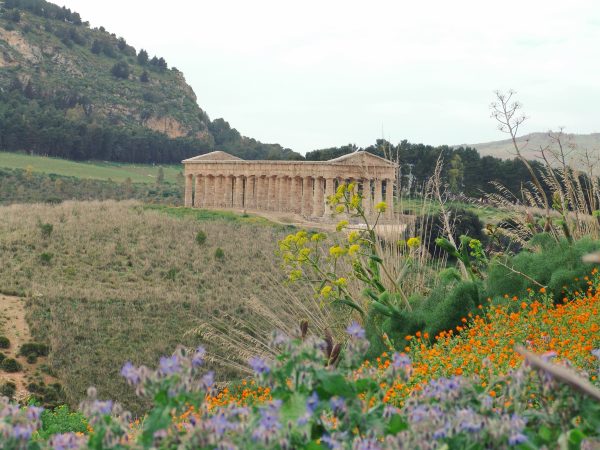Archaeological Park of Segesta
Segesta (or Egesta) was the most important of the cities of the Elymians, the remains of the ancient center have been identified on Monte Barbaro about 4 km away. north-west of the municipality of Calatafimi-Segesta. Most of the remains found belong to the Greek period, although there is no lack of archaeological evidence that demonstrates an oriental influence even before the Greek colonization. Surely before the arrival of the Elimi the place was a Sicano center. Mount Barbaro is a limestone relief consisting of two peaks of about 400 m divided by a valley. Its slopes are very steep except for the northern side which slopes more gently. On the northern summit are the ancient theater, the castle, the medieval mosque and the fifteenth-century church. But the excavations have also brought to light an Islamic necropolis, a Christian cemetery connected to the three-apsed church, a village with houses built, in various building phases, between the second half-end of the twelfth century. and the first half of the thirteenth century. and other houses from the Swabian period in more secluded areas.

Coin Didramma (480-461 BC) Front: Standing dog to d.
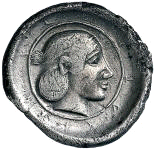
Didramma Coin (480-461 BC) Back: Nymph Head Segesta
Background
The date of its foundation is not known, but documents show that the city was inhabited in the 2th century BC The Greek historian Thucydides (History of the Peloponnesian War. Lib.VI.XNUMX) tells that the Trojan refugees, crossing the Mediterranean Sea, arrived as far as Sicily, and founded Segesta and Erice. These refugees took the name of Elimi. According to the myth, Segesta was founded by Aceste (who was its first king), son of the Trojan noble Egesta and the river god Crimiso.
There are those who say that the origin of the Elimi was the Italian peninsula. As proof that population of Ligurian origin occupied the western areas of Sicily, Ettore Pais (History of Ancient Italy) points out the similarity of the names of Sicilian places such as Eryx (Erice) Entella and Segesta, with those of Eryx (Lerici) in the gulf of La Spezia, Segesta (Sestri), and in the nearby Entella river mentioned by the poet Dante.
Due to his conflicting relations with Selinunte he asked for help during the Peloponnesian war in Athens, providing the pretext for Sparta's rival, to undertake what later turned out to be a disastrous expedition to Sicily (415-413) for Sparta. The clashes with Selinunte ended in 409 BC, when Selinunte was besieged and destroyed by the Carthaginians, again invoked by the Segestani. In 307 BC many Segestani were terribly killed or sold as slaves by the Syracusan tyrant Agàtocle for not having provided him with the requested economic aid. Agatocles, after the ferocious repression, changed the name of the city to Diceopolis (right city). In 276 BC the city returned under Punic influence, but in the First Punic War, in 260 BC it allied itself with the Romans who had great respect for it because, according to tradition, they had common origins (both descending from fugitives from Troy). The Romans defended it from the Carthaginian attempted reconquest. It was therefore guaranteed the status of a free city, with exemption from the imposition of taxes, unlike other Sicilian cities (civitas free ac immunis).
It was in 104 BC that the slave revolts in Sicily began from Segesta, the so-called servile wars, led by Athenion. These riots were bloodied by the Romans in 99 BC
Segesta was destroyed by the Vandals in the fifth century, and never rebuilt in the size of the previous period.
Nonetheless, there remained a small fortified settlement thanks to the Roman age walls that remained intact. It seems that the place was abandoned towards the VI-VII century and repopulated by Arab population towards the XII century who built a village and a mosque there. The name of Segesta changed to “Qualat Barbari”, that is the Berber Castle, better known by the Latinized name of Calatabarbaro Castle and, after the expulsion of the Arabs, the Normans built a castle there. This, enlarged in the Swabian era, was the center of a medieval village. In the second half of the thirteenth century. a bloody event led to the gradual abandonment of the place, while the nearby Calatafimi came to be populated. In 1442 some inhabitants of Calatafimi built the small church of S. Leone, above the one from the Swabian period. The construction of the Church of S. Leone constitutes the last true testimony of life in the locality.
The Myth of Crimiso
Crimiso is the Sicilian river god who turned into a dog and joined the Trojan Egesta (or Segesta) when she arrived in Sicily. From their union was born Aceste (or Egesto), founder of the city of Segesta, who happily welcomed Aeneas and the Trojans when they landed in Sicily. The dog is the element that is once again linked to oriental culture, and precisely in the Segestan coinage this symbol appears several times, perhaps as a reminder of the cult of Crimiso. There are different versions of the arrival in Sicily of the Trojan Segesta. One of these narrates that, due to discord between the king of Troy, Laomedonte, and his magnate, a certain Fenodamante, the king had the latter arrested and killed and all his male descendants and decided, instead of handing over the three daughters to merchants with the requirement that they be taken to distant lands. The girls, escaped from death thanks to the goddess Aphrodite, were taken to Sicily where, upon their arrival, they erected a temple to the goddess who had protected them. One of these girls was our Segesta.
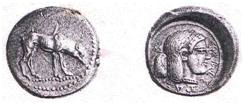
Didramma of Segesta (470 BC ca). On one side it represents a sniffing dog and on the other the head of the nymph Segesta with necklace earring and diadem (web)
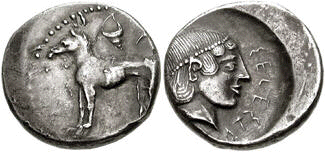
Didramma of Segesta (470 BC ca). On one side it represents a standing dog on the left. and on the other the diademed head of the nymph Segesta (web)
Monuments inside the Park (for details see the cards in the multimedia archive containing the sites concerned: Segesta Archive
- The Doric Temple
- Il Teatro
- The Calatabarbaro Castle and fortified area
- Agora
- Door to Valley
- Church of Monte Barbaro
- Mosque
- Contrada Mango Sanctuary
To these monuments we wanted to include some archaeological sites located outside the archaeological park of Segesta and reported in the Regional Landscape Plan Map: http://map.sitr.regione.sicilia.it/gis/rest/services/Beni_Culturali
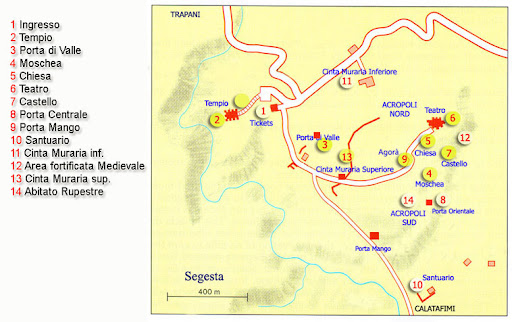
Archaeological area map (web)
Multimedia map with all interested sites: Segesta Archive
To these monuments we wanted to include some archaeological sites located outside the archaeological park of Segesta and reported in the Regional Landscape Plan Map: http://map.sitr.regione.sicilia.it/gis/rest/services/Beni_Culturali

- Contrada Pispisa - Apostolo farmhouses
- Contrada Pispisa - Baglio Salanca
- Contrada Morgana - Baglio Margana Soprana
- Margareta Soprana
- Contrada Strasalto di Badia - Timpone Santa Croce
- Monte Barbaro Piccolo
Card insertion: Ignazio Caloggero
Information contributions: Web, Region of Sicily
Photo: Ignazio Caloggero / Web
Note: The populating of the files of the Heritage database proceeds in incremental phases: cataloging, georeferencing, insertion of information and images. The cultural property in question has been cataloged, georeferenced and the first information entered. In order to enrich the information content, further contributions are welcome, if you wish you can contribute through our area "Your Contributions"


